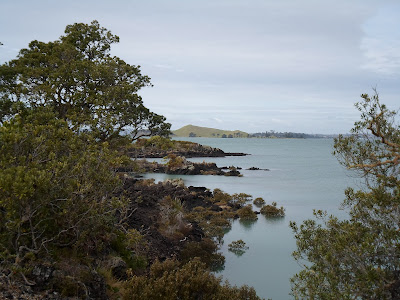The fact there isn't much to see wasn't that bad because I lost an entire day doing paper work. After the IEP (International Exchange Program) orientation session, where they talked about living, traveling and working in New-Zealand, I had to go get my drivers license translated, I had to apply for an IRD number (so I can legally work over here), I opened a bank account, got a new phone number and I got myself a bus pass. Not everything is sorted yet. I might have a bank account but there is still no money on it. I still have to figure out a way to get my money on it without losing to much on exchange rates and bank fees. But the bank is closed over the weekend so it will have to wait until Monday.
My last day in Auckland I was desperate to get out of the city so I took the ferry to Rangitoto Island, just half an hour into the Hauraki gulf. Rangitoto is actually a volcano that emerged from the sea only 600 years ago. There were Maori tribes present on the nearby island of Motutapu to witness the eruption. Because of this dramatic display of power (imagine a volcano erupting only a few 100m from your doorstep) Rangitoto became an important part of Maori history and culture. Therefore the volcano crater is considered wahi tapu (sacred place) until today. However the island is less than 600 years old it's completely covered with trees. The native Pohutukawa tree adapted best to the harsh conditions on this lava rock island and is the dominant species. Rangitoto has the largest remaining Pohutukawa forest in New-Zealand. The forest was almost completely destroyed by possums and wallabies, introduced by European settlers at the end of the 17th century. That's why the Department of Conservation started a massive pest eradication program on the island in the 90ties. They removed all the not native species from the island and since 2011 Rangitoto is considered a pest free natural reserve. Now the Pohutukawa forest flourishes again and the island is a wonderful place for a walk. It has a summit track that takes you to the 260m high crater, it has lava caves to explore and a coastal track that takes you through the forest. The narrow coastal track is quite the adventure, it took me nearly 2 hours to walk the 5km track. At some points it was more like rock climbing than walking. But I was alone on the track and surrounded by nature, it was the best fun I had since I arrived. This is what I came to New-Zealand for.
the lava caves I crawled through. Luckly the DOC ranger told me to bring a torch.
View from the crater summit. The island in the background is Motutapu.
the coastal track walk, can you see the track? I couldn't sometimes.
View from the coastal track
At the moment I'm in Tauranga, a nice town by the ocean in the Bay of Plenty. I'll tell you all about it later





Geen zwavel-luchtje in die tunnels? :)
ReplyDeleteSkoën foto's trouwens!
Allez, vooruit, ik moet toegeven: ziet er schoon uit. En ge waart daar helemaal alleen op die track? Lijkt veel op de 'eerste die ergens komt' en onze andere spelonk en eerste-stap-op-de-maan verhalen. :-)
ReplyDeleteEn ge had een torch bij?! Goed, dan kunt ge veel Carl Sagan lezen in de verloren uurtjes! zelfs in sspelonken! ;-p Aan hoeveel bladzijden zit ge al?!
j/k. Amuseert u daar, he.
PS.Ge kunt hier niet simpel anonymous posten?? :-( Chance dat ik al een google+ account had.
A little bit jealous. No, make that 'a lot'.
ReplyDelete